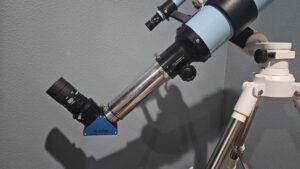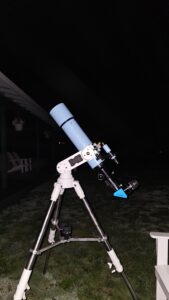Brandon 94mm f/7 Review
By: Vlad Fedosov
01/19/2024
Intro/History:
The Brandon 94mm f/7 is a bit of a legend in its own right. I have seen these come up for sale used over the years(though quite rarely I will say). This was a scope that came a little before my time(in the hobby that is). The Brandon 94mm was a highly regarded refractor telescope produced by VERNONscope, a US-based telescope distributor and retailer, during the late 1980s and early 1990s. So why the legendary status? Well, these featured a Roland Christen of AstroPhysics triplet APO lens (air-spaced triplet objective) usually known for excellent color correction and sharp images. This is the bit that had me interested in the scope, and when one came up for sale locally I had to own it being an AstroPhysics fan! So how does the scope stack up to an actual AstroPhysics??? Well, read on to find out…
The particular sample that I bought was a 1-owner BUT VERY WELL used. The unit was in overall good shape BUT the paint did have some scrapes/scratches as shown in the pictures. Optics are in quite a nice shape for the age and did not show any degradation in the coatings. The paint on these is a curious baby blue which I think looks great, but my wife could never get over(she was not a fan and wanted it gone from the living room…;). The Brandon’s were made by VERNONscope in partnership with Nihon Seiko in Japan for parts, including the objective lens cell and interchangeable components with Unitron telescopes.


Testing:
I did the test of the Brandon 94mm from my simi-dark mag 5 backyard. Before getting to the optics of the scope I will briefly mention the mechanical aspect of the scope. Overall there is not too much difference about the overall build of the entire optical tube compared to most other refractors(by todays standards closer to the mid-range). I will say that compared to more modern scopes the thing that stands out the most is the focuser. As mentioned above this scope shares some components from Unitron refractors and the focuser is straight from them. Overall I will say that it’s a basic 1-speed 2″ unit that is servisable but certainly not a Feathertouch or Moonlight(if you’re not familiar, the two best telescope focuser brands by a mile). It does however have a curius feature in a built-in extension tube. This is really handy for doing astrophotography!

Getting on to the optics I started by looking at the moon. Taking a look at a relatively low power that displayed the entire disk of our satellite. The view was nice and contrasty. Seeing was not the best so it was hard to judge how sharp the image was. At the low power that I was operating, I really did not see too much secondary color. Satisfied with the first look I moved on to doing a star test on the scope. Pointing to Capella I started out by confirming that the collimation of the scope was spot on! This was kind of expected as from what I understand this is a cemented triplet.
Perfect star test in and out of focus(though one side of focus was much brighter than the other), which is expected from a triplet that was made by Astrophysics! With powers over 100x I could see some purple secondary color around bright stars. Certainly not up to snuff with modern glass ED triplets.

With the star test out of the way I moved on to looking at a few deep sky objects. M42 was out so of course I had to take a look. No disappointment there! The nebula presented a good amount of detail and showed a lot of contrast. I then also took a look at a couple of open clusters including m45 and m37. Nice star display as expected from a refractor. Overall I was having a good time with the scope! Jupiter was also high in the sky and that was too juicy of a target to not take a look at. I cranked up the power to about 150x and the king of the planets displayed a decent amount of detail. Seeing was not the best so again it was a bit hard to judge how sharp an image is possible with the scope. I can confirm that there certainly was a decent amount of secondary color around the planet. Mind you this is not my first experience with a pre-ED AstroPhysics triplet. I previously owned an AstroPhysics Starfire 152mm that was roughly from the same time period as this Brandon. The 152mm was slower at f/9 but also much larger objective. The 152mm did have much better color correction which is quite surprising. Not sure if more attention was given to actual AstroPhysics scope objectives compared to what Brandon’s received?
Conclusion:
I was really excited to try one of these Brandon scopes. After trying it out I think it’s a pretty good scope but if I’m to be honest I did not really see anything special about it both mechanically or opticly. I really think that a modern import triplet is a better choice both mechanically and optically (especially regarding color correction). Having said that if you remember these from back in the day and have always wanted one, I would not hesitate to scratch that itch as it’s still a fine instrument!

